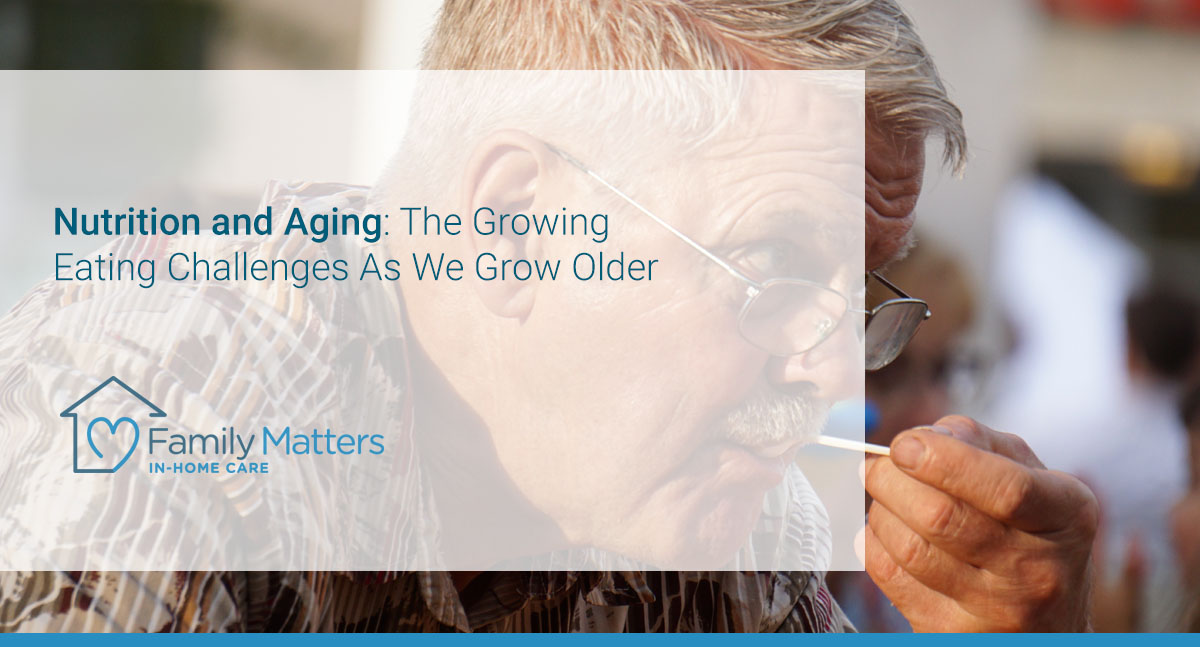
Nutrition and Aging: The Growing Eating Challenges As We Grow Older
Whether it’s to stay healthy, in social gatherings with friends, or as an expression of our creativity, food is central to our days and happiness. Most people have food-related stories around their social events or holidays.
However, as we age, sometimes that joy is diminished by our body’s decreased capacity to intake nutrients, mechanical issues with chewing and digestion, and a declining sense of taste.
When eating is no longer enjoyable, it can be tempting to skip eating or to choose foods that are quick and easier to prepare. Unfortunately, our loved ones do not have the luxury of pursuing these simpler, and less healthy, choices while maintaining their health.
Malnutrition is a gateway to weakness, loss of muscle strength, wounds that don’t heal as quickly, and reduced mental capacity. One study noted that over 43% of older patients admitted to intensive care were malnourished and that they were more likely to have complications and longer hospital stays than other patients.
Causes of Unhealthy Eating Styles As We Age
It’s important to watch out for things that might cause your loved one to eschew a healthy eating style:
- Medications can impair smell and taste, making food seem less appetizing.
- Conditions which affect the teeth or mouth can make chewing and swallowing difficult.
- Arthritis can make holding a fork or knife painful leading to an over-reliance on snack and finger foods.
- Losing their partner, and the subsequent depression and feelings of isolation, can remove the desire to prepare a meal for just themselves.
- Reduced income may mean that choices must be made between quality foods and other living costs.
- Physicians are rarely as well trained in nutrition and may treat the symptoms of malnutrition with drugs and therapy, without realizing that the cause could easily be remedied with a better diet.
Meal Services For Older Adults
If you are not nearby to monitor your loved ones’ eating habits, it might be worth looking into a service such as Meals on Wheels where they will bring healthy foods to your older adult and, at the same time, look in on whether they seem to be eating what is brought. A side benefit is that often the people who bring the meals will sit with your loved one for a snack or chat, adding a social component to the nutritional one.
Guidelines To Help Mitigate Malnutrition in Seniors
In order to stay ahead of malnutrition challenges, encourage your older adult to follow these guidelines:
- Eat whole foods that offer a lot of nutrients without extra calories such as brightly colored fruits and vegetables, whole grains, dairy with added vitamin D and calcium, seafood and lean meats, eggs, beans nuts and seeds.
- Avoid foods with empty calories such as those that are highly processed as well as soda and alcohol.
- Choose foods that are lower in fat and not fried.
- Drink plenty of liquids, especially water.
- Reduce salt consumption and increase spices that add flavor to the foods.
- Increase exercise of any kind as it can work to stimulate appetite.
What Nutrients are Most Beneficial?
• B6 found in whole grains and organ meats
• B12 found in lean meats and fish
• Folate found in dark greens, beans and peas
• Calcium and vitamin D found in dairy and dark
green vegetables
• Fiber found in beans and whole grains
• Healthy fats found in avocado, nuts, seeds and fish
• Potassium found in bananas, potatoes and yogurt
If your loved one simply has a small appetite, you can help them add calories and nutrition without adding bulk by introducing sauces or gravies and/or grated cheese to dishes. Stirring powdered milk into dishes can add calcium.
Adding honey, molasses or maple syrup to their breakfast cereal can help raise their blood sugar. Adding wheat germ to cereals and baked goods can increase the nutritional value without adding bulk. Additionally, consider suggesting more small meals during the day instead of a couple of larger ones that can be overwhelming to both prepare and to eat.
It helps to make sure that your loved one is following a regular schedule for meals so that it is as simple as looking at a clock to know that it is time to eat. If they don’t remember to look at clocks, find a calendar or app that will sound an alarm for breakfast, lunch, snacks and dinner.
Also, encourage them to find a friend or neighbor to share meals with several times a week. Social eating can be an encouragement to stay healthy.
If you or your family member is considering in-home care as part of a plan to age in place, contact Family Matters In-Home Care today for a free consultation. Our team is dedicated to supporting your family and helping older adults enjoy life in the comfort of their own home for as long as possible.
Some of the services offered by Family Matter In-Home Care include: Alzheimer’s & Dementia Care, Bed & Wheelchair Transfer Assistance, Companionship, Housekeeping & Meal Preparation, Personal Care, Recovery Care, and Transportation.
Serving the San Francisco Bay Area and Greater San Diego, Family Matter In-Home Care has offices throughout California including: Campbell, CA, Roseville, CA, San Marcos, CA, and San Mateo, CA.
Sources:
- https://f.hubspotusercontent30.net/hubfs/1708580/Marketing%20Monthlies/PDFs/0921-MM-Eating-Challenges.pdf
- https://now.tufts.edu/articles/nutrition-challenges-we-age
- https://www.winchesterhospital.org/health-library/article?id=8749
- https://medlineplus.gov/nutritionforolderadults.html
- https://health.clevelandclinic.org/how-to-age-better-by-eating-more-healthfully/
- https://www.webmd.com/healthy-aging/senior-nutrition#1
